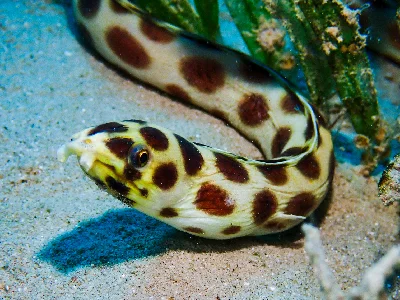Spotted Snake Eel
Myrichthys maculosus
The Myrichthys maculosus, commonly known as the Tiger Snake Eel, Ocellate Snake Eel, or Spotted Snake Eel, is a distinctive species of marine fish belonging to the Ophichthidae family. These eels are native to the tropical and warm temperate waters of the Indo-Pacific region, with a range extending from East Africa and the 🌊 Red Sea to 🇵🇫 French Polynesia and the Galápagos Islands, but they are absent in Hawaii.
Tiger Snake Eels can grow up to 1 meter (40 inches) in length, though they are more commonly observed at lengths of about 50 centimeters (20 inches). They possess an elongated body and exhibit a pale cream or yellow coloration adorned with large circular or oval dark spots. The younger eels display a single longitudinal row of spots, whereas the spots can number up to three rows in older specimens.
The Myrichthys maculosus thrives in sandy areas associated with reef flats, lagoons, and seaward reefs, generally at depths ranging from 1 to 262 meters (approximately 3 to 860 feet). During the day, these eels often stay buried in the sand with only their tails exposed, relying on their strong sense of smell to locate prey such as crustaceans and small fish. They may become more visible at night, especially at sites with artificial lighting, sometimes appearing in large numbers.
Anatomically, this species lacks dorsal and anal spines and features a small head with a short snout and long tubular nostrils that point downward. It has rows of teeth on both the jaws and the palate but lacks pelvic and caudal fins. The dorsal and anal fins run along the body, starting just behind the head and midway along the body, respectively, extending nearly to the tail tip.
The Tiger Snake Eel is primarily nocturnal, and although little is known about their reproductive behaviors, they possess distinct sexes, and their larvae, known as leptocephali, have a unique leaf-like appearance. The species holds commercial significance in fisheries and is also valued in the aquarium trade.
Comments
Please, sign in to leave comment
No Comments yet
Last Update: May 28, 2025

